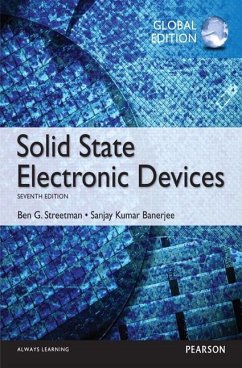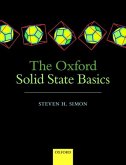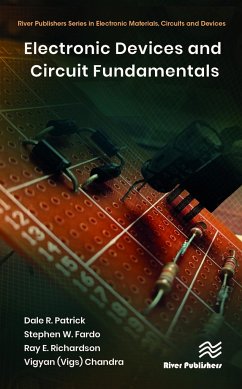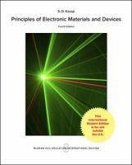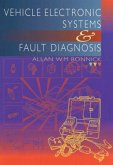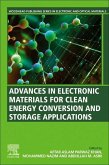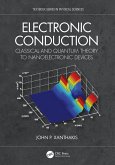For undergraduate electrical engineering students or for practicing engineers and scientists interested in updating their understanding of modern electronics
One of the most widely used introductory books on semiconductor materials, physics, devices and technology, Solid State Electronic Devices aims to: 1) develop basic semiconductor physics concepts, so students can better understand current and future devices; and 2) provide a sound understanding of current semiconductor devices and technology, so that their applications to electronic and optoelectronic circuits and systems can be appreciated. Students are brought to a level of understanding that will enable them to read much of the current literature on new devices and applications.
Teaching and Learning Experience
This program will provide a better teaching and learning experience–for you and your students. It will help:
Provide a Sound Understanding of Current Semiconductor Devices: With this background, students will be able to see how their applications to electronic and optoelectronic circuits and systems are meaningful.
Incorporate the Basics of Semiconductor Materials and Conduction Processes in Solids: Most of the commonly used semiconductor terms and concepts are introduced and related to a broad range of devices.
Develop Basic Semiconductor Physics Concepts: With this background, students will be better able to understand current and future devices.
Features + Benefits
Provide a Sound Understanding of Current Semiconductor Devices
The authors have chosen devices to discuss that are broadly illustrative of important principles at the undergraduate level.
The basics of semiconductor materials and conduction processes in solids are incorporated to understand p-n junctions, bipolar and metal oxide semiconductor transistors, optoelectronic and other devices.
A discussion of device fabrication processes and CMOS integrated circuit technology, along with data in the Appendices, provide a useful understanding of how semiconductor devices are made.
The extensive discussion of circuit and other application examples provides students with feedback about the practical relevance of the theory.
UPDATED: The discussion of MOS devices is updated, both in the underlying theory of ballistic FETs as well as discussion of advanced MOSFETs such as FinFETs, strained Si devices, metal gate/ high-k devices, III-V high channel mobility devices.
UPDATED: The treatment of optoelectronic devices is updated, including high bandgap nitride semiconductors and quantum cascade lasers
NEW: A brand new section on nanoelectronics introduces students to exciting concepts such as 2D materials including graphene and topological insulators, 1D nanowires and nanotubes, and 0D quantum dots.
NEW: A new discussion highlights spintronics and novel resistive and phase change memories.
Incorporate the Basics of Semiconductor Materials and Conduction Processes in Solids
All of the devices covered are important in today’s electronics; furthermore, learning about these devices should be an enjoyable and rewarding experience.
The first four chapters of the book provide background on the nature of semiconductors and conduction processes in solids.
Included is a brief introduction to quantum concepts (Chapter 2) for those students who do not already have this background from other courses.
Chapter 5 describes the p-n junction and some of its applications.
Chapters 6 and 7 deal with the principles of transistor operation.
Chapter 8 covers optoelectronics and Chapter 9 discusses integrated circuits.
Chapter 10 applies the theory of junctions and conduction processes to microwave and power devices.
Develop Basic Semiconductor Physics Concepts
NEW: This edition features about 100 new problems and updated references that extend concepts in the text.
Reading Lists: As a further aid in developing techniques for independent study, the reading list at the end of each chapter includes a few articles which students can read as they study this book. Some exposure to periodicals is useful in laying the foundation for a career of constant updating and self-education. A summary of the key concepts is included at the end of each chapter.
Problems: One of the keys to success in understanding this material is to work problems that exercise the concepts. The problems at the end of each chapter are designed to facilitate learning the material. Very few are simple “plug-in” problems. Instead, they are chosen to reinforce or extend the material presented in the chapter. In addition, “self quiz” problems test students’ conceptual understanding.
Key Equations: A listing of the key equations for semiconductor devices on the inside covers of the book is arranged thematically to help students digest the concepts.
Units: Examples and problems are stated in terms of units commonly used in the semiconductor literature. The basic system of units is rationalized MKS, although cm is often used as a convenient unit of length. Similarly, electron volts (eV) are often used rather than joules (J) to measure the energy of electrons. Units for various quantities are given in Appendices I and II.
For undergraduate electrical engineering students or for practicing engineers and scientists interested in updating their understanding of modern electronics One of the most widely used introductory books on semiconductor materials, physics, devices and technology, Solid State Electronic Devices aims to: 1) develop basic semiconductor physics concepts, so students can better understand current and future devices; and 2) provide a sound understanding of current semiconductor devices and technology, so that their applications to electronic and optoelectronic circuits and systems can be appreciated. Students are brought to a level of understanding that will enable them to read much of the current literature on new devices and applications. Teaching and Learning Experience This program will provide a better teaching and learning experience?for you and your students. It will help: * Provide a Sound Understanding of Current Semiconductor Devices: With this background, students will be able to see how their applications to electronic and optoelectronic circuits and systems are meaningful. * Incorporate the Basics of Semiconductor Materials and Conduction Processes in Solids: Most of the commonly used semiconductor terms and concepts are introduced and related to a broad range of devices. * Develop Basic Semiconductor Physics Concepts: With this background, students will be better able to understand current and future devices.
One of the most widely used introductory books on semiconductor materials, physics, devices and technology, Solid State Electronic Devices aims to: 1) develop basic semiconductor physics concepts, so students can better understand current and future devices; and 2) provide a sound understanding of current semiconductor devices and technology, so that their applications to electronic and optoelectronic circuits and systems can be appreciated. Students are brought to a level of understanding that will enable them to read much of the current literature on new devices and applications.
Teaching and Learning Experience
This program will provide a better teaching and learning experience–for you and your students. It will help:
Provide a Sound Understanding of Current Semiconductor Devices: With this background, students will be able to see how their applications to electronic and optoelectronic circuits and systems are meaningful.
Incorporate the Basics of Semiconductor Materials and Conduction Processes in Solids: Most of the commonly used semiconductor terms and concepts are introduced and related to a broad range of devices.
Develop Basic Semiconductor Physics Concepts: With this background, students will be better able to understand current and future devices.
Features + Benefits
Provide a Sound Understanding of Current Semiconductor Devices
The authors have chosen devices to discuss that are broadly illustrative of important principles at the undergraduate level.
The basics of semiconductor materials and conduction processes in solids are incorporated to understand p-n junctions, bipolar and metal oxide semiconductor transistors, optoelectronic and other devices.
A discussion of device fabrication processes and CMOS integrated circuit technology, along with data in the Appendices, provide a useful understanding of how semiconductor devices are made.
The extensive discussion of circuit and other application examples provides students with feedback about the practical relevance of the theory.
UPDATED: The discussion of MOS devices is updated, both in the underlying theory of ballistic FETs as well as discussion of advanced MOSFETs such as FinFETs, strained Si devices, metal gate/ high-k devices, III-V high channel mobility devices.
UPDATED: The treatment of optoelectronic devices is updated, including high bandgap nitride semiconductors and quantum cascade lasers
NEW: A brand new section on nanoelectronics introduces students to exciting concepts such as 2D materials including graphene and topological insulators, 1D nanowires and nanotubes, and 0D quantum dots.
NEW: A new discussion highlights spintronics and novel resistive and phase change memories.
Incorporate the Basics of Semiconductor Materials and Conduction Processes in Solids
All of the devices covered are important in today’s electronics; furthermore, learning about these devices should be an enjoyable and rewarding experience.
The first four chapters of the book provide background on the nature of semiconductors and conduction processes in solids.
Included is a brief introduction to quantum concepts (Chapter 2) for those students who do not already have this background from other courses.
Chapter 5 describes the p-n junction and some of its applications.
Chapters 6 and 7 deal with the principles of transistor operation.
Chapter 8 covers optoelectronics and Chapter 9 discusses integrated circuits.
Chapter 10 applies the theory of junctions and conduction processes to microwave and power devices.
Develop Basic Semiconductor Physics Concepts
NEW: This edition features about 100 new problems and updated references that extend concepts in the text.
Reading Lists: As a further aid in developing techniques for independent study, the reading list at the end of each chapter includes a few articles which students can read as they study this book. Some exposure to periodicals is useful in laying the foundation for a career of constant updating and self-education. A summary of the key concepts is included at the end of each chapter.
Problems: One of the keys to success in understanding this material is to work problems that exercise the concepts. The problems at the end of each chapter are designed to facilitate learning the material. Very few are simple “plug-in” problems. Instead, they are chosen to reinforce or extend the material presented in the chapter. In addition, “self quiz” problems test students’ conceptual understanding.
Key Equations: A listing of the key equations for semiconductor devices on the inside covers of the book is arranged thematically to help students digest the concepts.
Units: Examples and problems are stated in terms of units commonly used in the semiconductor literature. The basic system of units is rationalized MKS, although cm is often used as a convenient unit of length. Similarly, electron volts (eV) are often used rather than joules (J) to measure the energy of electrons. Units for various quantities are given in Appendices I and II.
For undergraduate electrical engineering students or for practicing engineers and scientists interested in updating their understanding of modern electronics One of the most widely used introductory books on semiconductor materials, physics, devices and technology, Solid State Electronic Devices aims to: 1) develop basic semiconductor physics concepts, so students can better understand current and future devices; and 2) provide a sound understanding of current semiconductor devices and technology, so that their applications to electronic and optoelectronic circuits and systems can be appreciated. Students are brought to a level of understanding that will enable them to read much of the current literature on new devices and applications. Teaching and Learning Experience This program will provide a better teaching and learning experience?for you and your students. It will help: * Provide a Sound Understanding of Current Semiconductor Devices: With this background, students will be able to see how their applications to electronic and optoelectronic circuits and systems are meaningful. * Incorporate the Basics of Semiconductor Materials and Conduction Processes in Solids: Most of the commonly used semiconductor terms and concepts are introduced and related to a broad range of devices. * Develop Basic Semiconductor Physics Concepts: With this background, students will be better able to understand current and future devices.

